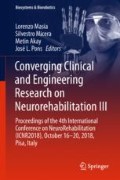Abstract
The RETRAINER S1 system is an upper limb rehabilitation device designed to be used in repetitive task-oriented training. While the device itself is intrinsically controlled by the wearer, the execution of the training exercises is automatically controlled by a finite-state machine. This contribution discusses three different control strategies tested in a clinical environment.
Research supported by European Union’s Horizon 2020 research and innovation program under grant agreement No 644721.
Access this chapter
Tax calculation will be finalised at checkout
Purchases are for personal use only
References
Lawrence, E.S., et al.: Estimates of the prevalence of acute stroke impariments and disability in a multiethnic population. Stroke 32, 1279–1284 (2001)
Thomas, L.H., et al.: Repetitive task training for improving functional ability after stroke: a major update of a cochrane review. Stroke 48(4), e102–e103 (2017)
Knutson, J.S., Fu, M.J., Sheffler, L.R., Chae, J.: Neuromuscular electrical stimulation for motor restoration in hemiplegia. Phys. Med. Rehabil. Clin. N. Am. 26(4), 729–745 (2015)
Mehrholz, J., Pohl, M., Platz, T., Kugler, J., Elsner, B.: Electromechanical and robot-assisted arm training for improving activities of daily living, arm function, and arm muscle strength after stroke. Cochrane Database Syst. Rev. 11(11), CD006876 (2015)
Ambrosini, E., et al.: The combined action of a passive exoskeleton and an EMG- controlled neuroprosthesis for upper limb stroke rehabilitation: first results of the RETRAINER project * (2017)
Seel, T., Ruppin, S.: Eliminating the effect of magnetic disturbances on the inclination estimates of inertial sensors. IFAC-PapersOnLine 50(1), 8798–8803 (2017)
Author information
Authors and Affiliations
Corresponding author
Editor information
Editors and Affiliations
Rights and permissions
Copyright information
© 2019 Springer Nature Switzerland AG
About this paper
Cite this paper
Zajc, J., Puchinger, M., Russold, M., Gfoehler, M. (2019). Comparison of Three Control Strategies for an Upper Arm Rehabilitation Device. In: Masia, L., Micera, S., Akay, M., Pons, J. (eds) Converging Clinical and Engineering Research on Neurorehabilitation III. ICNR 2018. Biosystems & Biorobotics, vol 21. Springer, Cham. https://doi.org/10.1007/978-3-030-01845-0_32
Download citation
DOI: https://doi.org/10.1007/978-3-030-01845-0_32
Published:
Publisher Name: Springer, Cham
Print ISBN: 978-3-030-01844-3
Online ISBN: 978-3-030-01845-0
eBook Packages: EngineeringEngineering (R0)

